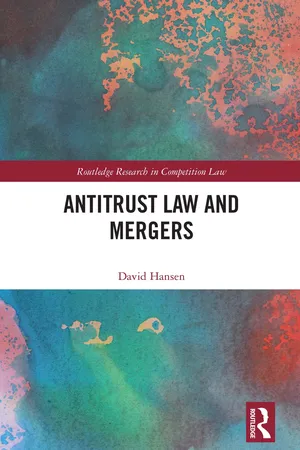
- English
- ePUB (mobile friendly)
- Available on iOS & Android
Antitrust Law and Mergers
About this book
This book discusses the economic models and quantitative research involved in merger control forecasts and the relationship between antitrust law and economics. Analyzing qualitative and quantitative models within forecasts of merger control, the book applies the framework of antitrust law.
This book proposes that economic modelling, econometrics application and juridical application of antitrust law go hand in hand. Discussing the question of an economically rational application and enforcement of antitrust and merger control law, the book covers both the basic concepts and theory behind economic model forecasts, as well as the application of merger control law. It also takes a closer look at legal control options for competition authorities when making a forecast decision and the associated problems of applying the law to this.
The book will be of interest to researchers in the field of antitrust law, competition law, economics and corporate law.
Frequently asked questions
- Essential is ideal for learners and professionals who enjoy exploring a wide range of subjects. Access the Essential Library with 800,000+ trusted titles and best-sellers across business, personal growth, and the humanities. Includes unlimited reading time and Standard Read Aloud voice.
- Complete: Perfect for advanced learners and researchers needing full, unrestricted access. Unlock 1.4M+ books across hundreds of subjects, including academic and specialized titles. The Complete Plan also includes advanced features like Premium Read Aloud and Research Assistant.
Please note we cannot support devices running on iOS 13 and Android 7 or earlier. Learn more about using the app.
Information
Table of contents
- Cover
- Half Title
- Series
- Title
- Copyright
- Dedication
- Contents
- Acknowledgements
- Introduction
- 1 The requisite standard of proof
- 2 The forecast period
- 3 Legal control of the forecasting decision and the competition authority’s margin of discretion
- 4 Selection method for choosing one among several rival prospective causal statements
- 5 Teleological functions, methods and stages of forecast decision-making
- 6 Case study: the judgments of the GC and the ECJ in the TetraLaval/Sidel case
- 7 Summary
- Bibliography
- Index